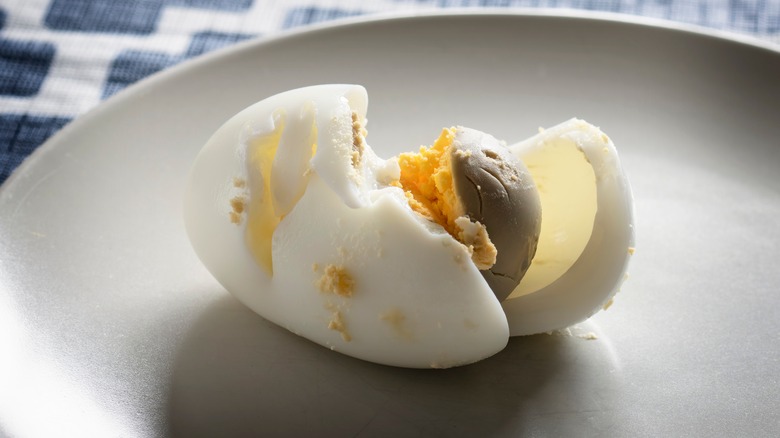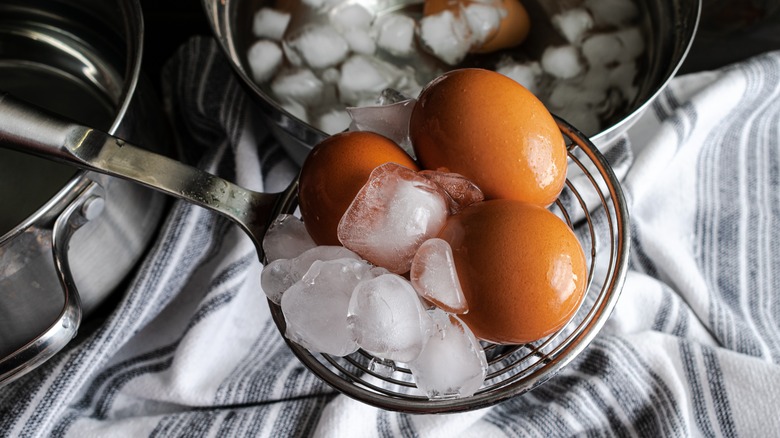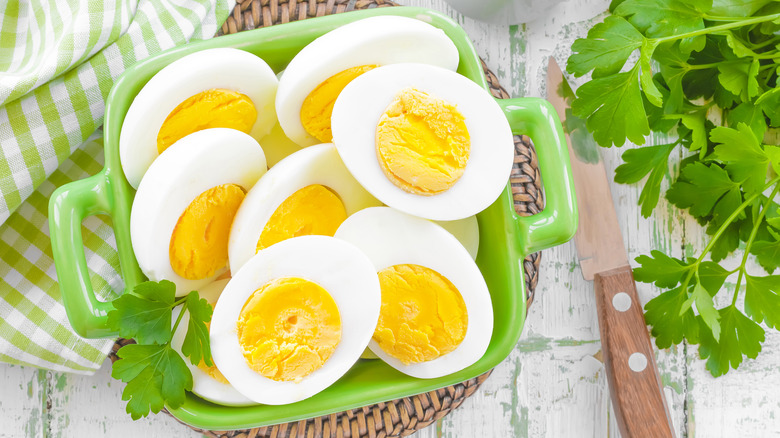Say Goodbye To Green Yolks With This Simple Trick
Dr. Seuss may have made green eggs and ham cool, but, when the yolks of our hard-boiled eggs end up with a grayish-green ring around the perimeter, it's just not as endearing as Sam I Am eating his green eggs in a tree. For aesthetic purposes, the ideal boiled egg yolk is a solid, yellow to orange color throughout. When a ring around the yolk can be seen, it just doesn't look so appetizing.
What may surprise some is that the green ring is completely avoidable and has nothing to do with the egg itself. The trick to avoiding any discoloration on the yolk is to not overcook your eggs and to cool them quickly when they're done. Overcooking hard-boiled eggs is really easy to do because, in order to ensure the yolk is cooked all the way through with no soft or runny spots, many people will boil the eggs vigorously and then, perhaps, let them cool slowly until they can be handled. Sure, the eggs will cook, but at the expense of their even, buttery color.
Instead of boiling, try simmering
Despite the name "hard-boiled eggs," you can get your eggs fully cooked in the shell without any hard boiling at all. There are several methods that promise to be the absolute best way to hard-boil and easily peel eggs (we're particularly partial to steaming, rather than boiling). However, if you want to cook your eggs submerged in water, then bringing water up to a boil in a pot first, placing the eggs in, and immediately lowering the heat to a gentle simmer is the way to go. After about 10 to 15 minutes (depending on the size of the eggs) remove the eggs and place them directly into a bowl of ice water to quickly cool them down. After about five minutes you can peel the eggs and they will be ready for eating whole, slicing for salad toppings, smashing for egg salad, or halving and stuffing for deviled eggs.
Some add vinegar or salt to the boiling water in order to make the eggs easier to peel, but others find this step unnecessary. Whichever way you prefer, just be sure you're keeping the heat moderate and cooling your eggs down swiftly. When you do this, your yolks should be ring-free when you cut the eggs open.
Why do eggs go green?
If the dark ring that appears on hard-boiled egg yolks doesn't have anything to do with the freshness of the egg, why does it even change color? You probably know that there is sulfur in egg whites, which explains the signature odor of a hard-boiled egg. When an egg is overcooked, the sulfur in the white will react with the iron in the egg yolk and together they make ferrous sulfide, which is naturally grayish-green in color. Despite the gangrene-ish appearance, the egg is perfectly safe to eat, although the texture won't be ideal. Overcooking hard-boiled eggs will result in dry, rubbery egg whites and crumbly, chalky egg yolks.
If you're smashing up the yolks for deviled eggs, or chopping up the whole egg for egg salad, you probably won't even notice the color or change in texture once other ingredients are stirred in. But if you're halving or quartering the eggs, the discoloration will be more obvious.
If eating with your eyes first is important to you, turn down the heat the next time you boil your eggs and keep a bowl of ice water handy. You'll have the best-looking hard-boiled eggs of your life.


